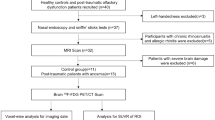Abstract
Purpose
To determine whether regional cerebral functional abnormalities exist in patients with apraxia of lid opening (ALO).
Methods
Cerebral glucose metabolism was examined by positron emission tomography (PET) in 11 patients (8 women and 3 men, age 48–69 years); 10 with ALO accompanied by blepharospasm and 1 patient with pure ALO. Eleven normal volunteers (6 women and 5 men, age 45–66 years) were examined as controls. A comprehensive ophthalmological examination, magnetic resonance imaging (MRI), and PET were performed. The cerebral glucose metabolism was evaluated by the relative uptake of [fluorine-18]fluorodeoxyglucose by PET. The mean ± two standard deviations of the normal controls was defined as the normal range for cerebral glucose metabolism.
Results
MRI revealed no particular lesion except for an infarction in the unilateral basal ganglia in two patients. Decreased glucose metabolism was observed in a wide area of the medial frontal lobe (six cases) and primary visual cortex (PVC) (four cases). Group multiple comparisons revealed a significant decrease (P<0.0035) in the bilateral anterior cingulate gyrus, left supplementary motor area (SMA), and bilateral PVC.
Conclusion
The results support the hypothesis that ALO is associated with hypofunction in the SMA and/or anterior cingulate gyrus.




Similar content being viewed by others
References
Aramideh M, Ongerboer de Visser BW (1994) Electromyographic features of levator palpebrae superioris and orbicularis oculi muscles in blepharospasm. Brain 117:27–38
Aramideh M, Ongerboer de Visser BW, Devriese PP et al (1994) Clinical and electromyographic features of levator palpebrae superioris muscle dysfunction in involuntary eyelid closure. Mov Disord 9:395–402
Ardekani BA, Braun M, Hurton DF et al (1995) "A fully automatic multimodality image registration algorithm." J Comput Assist Tomogr 19:615–623
Ball T, Schreiber A, Feige B et al (1999) The role of higher-order motor areas in voluntary movement as revealed by high-resolution EEG and fMRI. Neuroimage 10:682–694
Basso MA, Evinger C (1996) An explanation for reflex blink hyperexcitability in Parkinson's disease. 2. Nucleus raphe magnus. J Neurosci 16:7318–7330
Bodis-Wollner I, Bucher SF, Seelos KC (1999) Cortical activation patterns during voluntary blinks and voluntary saccades. Neurology 53:1800–1805
Ceballos-Baumann AO, Sheean G, Passingham RE et al (1995) Cerebral activation with stereotyped writing in patients with writer's cramp before and after botulinum toxin treatment: a PET study. Neurology 45: A393
Della SS, Francescani A, Spinnler H et al (2002) Gait apraxia after bilateral supplementary motor area lesion. J Neurol Neurosurg Psychiatry 72:77–85
Esmaeli GB, Nahmias C, Thompson M et al (1999) Positron emission tomography in patients with benign essential blepharospasm. Ophthalmic Plastic Reconstruct Surg 15:23–27
Esteban A, Gimenez-Roldan S (1988) Involuntary closure of eyelids in parkinsonism. Electrophysiological evidence for prolonged inhibition of the levator palpebrae muscles. J Neurol Sci 85:333–345
Galardi G, Perani D, Grassi F et al (1996) Basal ganglia and thalamo-cortical hypermetabolism in patients with spasmodic torticollis. Acta Neurol Scand 94:172–176
Goffinet AM, De Volder AG, Gillain C et al (1989) Positron tomography demonstrates frontal lobe hypometabolism in progressive supranuclear palsy. Ann Neurol 25:131–139
Goldstein JE, Cogan DG (1965) Apraxia of lid opening. Arch Ophthalmol: 73:155–159
Graham MM, Peterson LM, Hayward RM (2000) Comparison of simplified quantitative analyses of FDG uptake. Nucl Med Biol 27:647–655
Guze BH, Hoffman JM, Baxter LR et al (1991) Functional brain imaging and Alzheimer-type dementia. Alzheimer Dis Assoc Disord 5:215–230
Hutchinson M, Nakamura T, Moeller JR et al (2000) The metabolic topography of essential blepharospasm. A focal dystonia with general implications. Neurology 55:673–677
Kawashima R, Fukuda H (1998) Cortical control of voluntary movements: PET studies. Rinshyo Nouha 40:32–35
Keane JR (1988) Lid-opening apraxia in Wilson's disease. J Clin Neuro-ophthalmology 8:31–33
Kimbrell TA, Ketter TA (2002) Regional cerebral glucose utilization in patients with a range of severities of unipolar depression. Biol Psychiatry 2002 51:237–252
Krack P, Marion MH (1994) "Apraxia of lid opening," a focal eyelid dystonia: clinical study of 32 patients. Mov Disord 9:610–605
Lepore FE, Duvoisin RC (1985) "Apraxia" of eyelid opening: an involuntary levator inhibition. Neurology 35:423–427
May M, Galetta S (1990) The facial nerve and related disorders of the face. In: Glaser JS (ed) Neuro-ophthalmology, 2nd edn. 239–277
Piccione F, Mancini E, Tchin et al (1997) Botulinum toxin treatment of apraxia of eyelid opening in progressive supranuclear palsy: report of two cases. Arch Phys Med Rehabil 78: 525–529
Ridding MC, Sheean G, Rothwell JC (1995) Changes in the balance between motor cortical excitation and inhibition in focal, task specific dystonia. J Neurol Neurosurg Psychiatry 59:493–498
Shima K, Aya K, Mushiake H et al (1991) Two movement-related foci in the primate cingulate cortex observed in signal-triggered and self-paced forelimb movements. J Neurophysiol 65:188–202
Sibony PA, Evinger C (1997) Normal and abnormal eyelid function. In: Walsh and Hoyt's Clinical neuro-ophthalmology, 5th edn. 1509–1593
Smith D, Ishikawa T, Dhawan V et al (1995) Lid opening apraxia is assosiated with medial frontal hypometabolism. Mov Disord 10:341–344
Van Eimeren T, Boecker H, Konkiewitz EC et al (2001) Right lateralized motor cortex activation during volitional blinking. Ann Neurol 49:813–816
Verghese J, Milling C, Rosenbaum DM (1999) Ptosis, blepharospasm, and apraxia of eyelid opening secondary to putaminal hemorrhage. Neurology 53:652
Wessel K, Zeffiro T, Toro C et al (1997) Self-paced versus metronome-paced finger movements. J Neuroimaging 7:145–151
Yazawa S, Ikeda A, Kunieda et al (2000) Human presupplementary motor area is active before voluntary movement: subdural recording of Bereitschaftspotential from medial frontal cortex. Exp Brain Res 131:165–177
Author information
Authors and Affiliations
Corresponding author
Rights and permissions
About this article
Cite this article
Suzuki, Y., Kiyosawa, M., Ohno, N. et al. Glucose hypometabolism in medial frontal cortex of patients with apraxia of lid opening. Graefe's Arch Clin Exp Ophthalmol 241, 529–534 (2003). https://doi.org/10.1007/s00417-003-0682-0
Received:
Revised:
Accepted:
Published:
Issue Date:
DOI: https://doi.org/10.1007/s00417-003-0682-0




